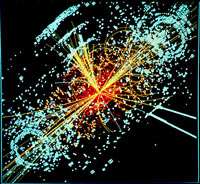Particle physics -- why does it matter?

Scientists reported yesterday the discovery of a particle that is very likely the Higgs boson, a subatomic particle that gives other particles mass—and makes life possible. Theorized in the 1960s and sometimes called “the God particle,” physicists have spent decades searching for it. What finally allowed them to find it were experiments at the Large Hadron Collider (LHC), a high-energy particle accelerator that runs in a 27-kilmometre circular tunnel buried 100 metres below the surface of the earth underneath France and Switzerland.
We spoke to U of T physics professor William Trischuk in June of 2011 about the project. He is one of group of U of T students and professors working on the experiments at the LHC. This is an edited version of that conversation.
What does the Large Hadron Collider do?
It allows us to accelerate subatomic particles to previously unimagined energies. There are other places in the universe—the Big Bang—where these kinds of energies have existed, but this is our only controlled way of studying what goes on at these energies.
Why do we want to do this?
If we produce higher energies and collision rates, these can be converted for brief instants in time to mass, to new particles. We know protons are all around us. At the LHC we are putting energy into them, accelerating them to energies that are 7,000 times what the protons have when they are not moving, and then colliding them. In principle, we can produce energies 14,000 times as high as the protons have on their own.
These are the types of energies that existed after the Big Bang. Particle physics has been chasing the Big Bang backwards to higher and higher energies. We now understand how things work at a millionth of a second after the Big Bang. We’re trying to go to a billionth of a second. Producing higher and higher energy collisions takes us back farther and farther toward the beginning of the Big Bang, when all the particles in the universe were made, but before they had coalesced to form protons and neutrons.
And why do we want to reproduce the Big Bang?
We have a Standard Model of physics that has allowed us to explain the world. Everything seems to fit together but we don’t understand why. The Standard Model is very rational. We can write down how it works. But we don’t understand why it works.
Colleagues in theoretical physics have got lots of great ideas and have written hundreds of papers, but physics is an observational science. We want to peel back the next layer of the Standard Model and put some order to it. The chemist Mendeleev catalogued the periodic table of the elements, but he didn’t know about nuclei and atoms and electrons. When science developed more sophisticated measurements it became clear why the periodic table has the structure it has. That’s what we’re trying to do now in particle physics.
As scientists, first we tried to understand how the atoms and molecules work in chemistry. Chemistry describes the periodic table and allows us to understand why some things are very reactive and some things are not. Then we tried to understand how the protons and neutrons work in nuclear physics. Neutrons and protons tell us how nuclei formed and why some can give us nuclear energy and others are stable and can’t. Now we’re trying to understand how different combinations of quarks make different particles.
Are there practical applications?
I bring up chemistry and nuclear physics because we’ve made something of them. When Mendeleev discovered the periodic table, nobody knew what chemistry would allow us to do in everyday life. When Rutherford discovered the nucleus, he was just trying to understand how things were put together, but for better worse, we found things to do with nuclei. We can get energy from them because we mastered the physics that explains to us how nuclear physics work.
This is the same kind of thing that one could imagine doing with the particles—this is the next phase. But all of these applications took 30 to 50 years. It’s still 10 years in our future before we begin to learn all the Large Hadron Collider can teach us about particle physics, and then we can begin to explore applications.
This is the way science and engineering have worked together for hundreds of years, going back to Newton with an apple falling on his head. Once we understand the principles, we find applications. I’m firmly convinced that we will find something, whether it will be science-fiction like warp drives, anti-matter, I don’t know. But understanding how it all fits together is the first step.
What is your interest in the Large Hardon Collider?
My interest is more in seeing what happens. Others are more focused on analyzing the data the LHC will yield. My specialty is in building pieces of the particle detector. It takes hundreds, maybe even a thousand people to build and maintain the facility. It’s an experiment that I do with 3,000 of my closest friends!
Provided by University of Toronto



















